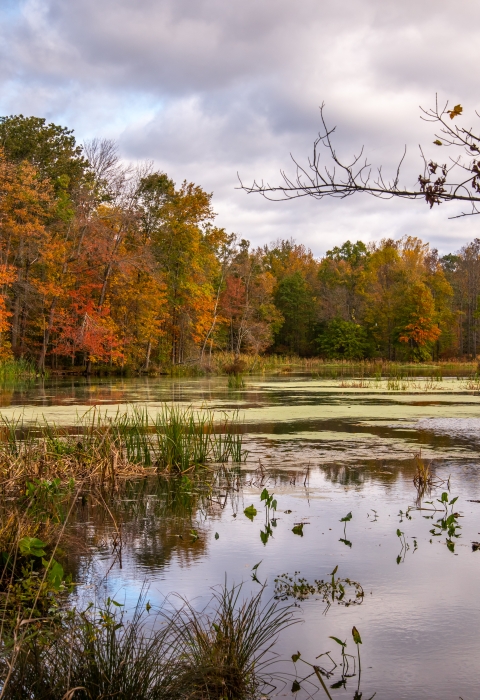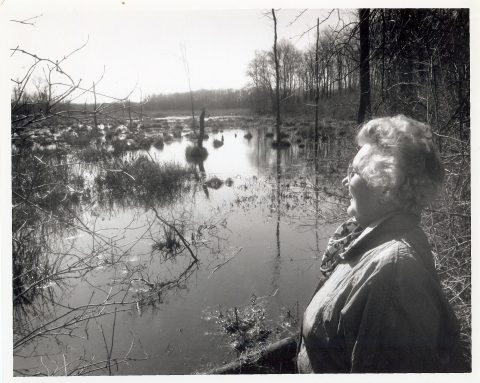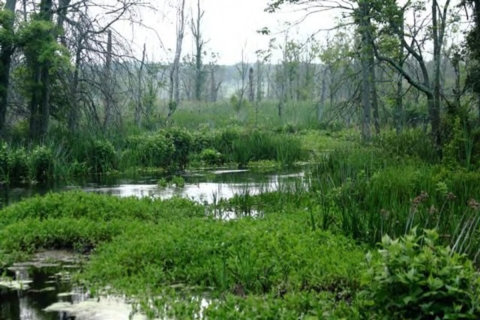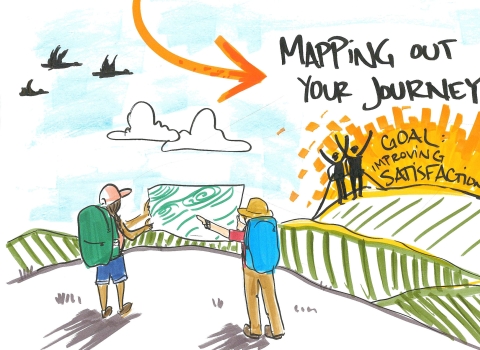By Michelle Reilly and Vanessa Kauffman
In 1919, Arthur Carhart, a recreation planner with the U.S. Department of Agriculture Forest Service, was sent to Trappers Lake in the White River National Forest to survey the area for a potential summer home development. He was stuck by area’s beauty and requested a meeting with Aldo Leopold, then-Forest Service assistant district forester in New Mexico. They discussed a new idea for public land that prioritized preservation of areas for their natural beauty, a designation that would combat the growing mechanization, industrialization, and expanding human developments that were occurring.
Following that meeting, Carhart drafted a memo summarizing their discussion and sent a copy to Leopold on Dec. 10, 1919. In it, he stated, “Returns from the Forests cannot be counted in total in terms of dollars and cents in the case of the aesthetic qualities within the Forests … it is almost impossible to reduce to a money basis the value returned to a Forest visitor when viewing the country from an especially scenic auto road, scenic trail, or outlook.”
RELATED: The Women of Wilderness
In 1935, the Wilderness Society was founded as an “organization of spirited people who will fight for the freedom and preservation of the wilderness.” This was contrary to the popular view at the time that public lands held only extrinsic values in the form of resources from logging, mining, and other developments. By the 1950s, with the rise of the environmental movement, Americans began to understand the importance of preservation of natural areas for their ecological benefits. In 1956, Howard Zanhiser, of the Wilderness Society, wrote the first draft of legislation to protect public lands as wilderness.
Around the same time in New Jersey, a small 1.618-hectare piece of marshy land just 26 miles from Times Square was garnering a lot of attention. Great Swamp Basin was formed by the melt from the Wisconsin Glacier, which left an assemblage of lands dissimilar to the surrounding areas. The basin, made up of meadows and sandy knolls with oak, beech, rhododendron, and laurels, was a popular spot for birders and botanists. The area was in close proximity to three universities, and thus there was an extensive body of research about the ecosystem. From this research, the area was known to be home to 39 species of mammals and a nesting site for 244 species of birds.
Great Swamp has a long history of land use dating back to the 1700s when the area was divided into hundreds of wood-lots and portions were drained, farmed, and logged. Locals who enjoyed Great Swamp for its unique ecology were also aware that because of its proximity to large population centers, it was of great interest to land developers. Word then got out from the press about a proposed international jetport that could occupy 10,000 acres in the Great Swamp area.
Helen Fenske, a concerned citizen, opened her home to concerned locals as a place to gather and plan to prevent Great Swamp from being filled in for this project.
The Great Swamp Committee was formed by the local citizens, and Fenske was appointed secretary. Fenske and Grace Hand, another member of the Great Swamp Committee went to Boston to meet with a U.S. Fish and Wildlife Service employee, John Gottschalk, to propose the establishment of a refuge at Great Swamp. They talked to Gottschalk and his staff about the closed ecosystem of Great Swamp, its unique plant assemblages,and the important habitats found there. They gathered a tremendous amount of biological and ecological information on the swamp. Gottschalk agreed the area could be a showcase for wildlife education. If they would raise money to purchase 3,000 acres, he would commit money from the Migratory Bird Fund to match their acreage and open an office with a refuge manager on the total 6,000 acres.
Despite many hurdles, the Great Swamp Committee was able to raise enough money for 2,600 acres of land. On May 29, 1964, Interior Secretary Stuart Udall, Service Director Dan Jantzen, and a large group of supporters met in Basking Ridge, New Jersey, to celebrate the establishment of Great Swamp National Wildlife Refuge.
On Sept. 3, 1964, President Lyndon Johnson signed the Wilderness Act into law saying, “This is a very happy and historic occasion for all those who love the great American outdoors, and that, needless to say, includes me … No single Congress in my memory has done so much to keep America as a good and wholesome and beautiful place to live.” The Wilderness Act created the National Wilderness Preservation System.
Fenske had not given up concern for Great Swamp. Reaching out to the people who helped get the refuge designated, Fenske said, “It was a groundswell that I’ve never seen since then on any of the projects that I’ve had.”
The Great Swamp did not constitute untouched wild land and this was true of some of the original areas designated in the Wilderness Act itself. The Wilderness Act did not require wilderness to be undisturbed. According to his biographer, Zahniser resisted attempts to persuade him to rewrite the wilderness definition, replacing “untrammeled” with “undisturbed.” This is because, unlike “undisturbed,” untrammeled wilderness accepts that the area may have been modified to some extent at some point in time. And Zahniser believed this was an important distinction and warranted use of the word untrammeled. And this has rung true since the act passed.
Thanks to all the public support, Congress passed a bill (S. 3379): "An Act to designate certain lands in the Great Swamp National Wildlife Refuge, Morris County, New Jersey as wilderness." On Sept. 28, 1968, President Johnson signed Public Law 90-532 designating 3,660 acres of the refuge as the Great Swamp Wilderness.
First Lady Lady Bird Johnson invited Fenske to the White House to talk about Great Swamp after the signing. “You have no idea how incredible that occasion was to be invited to the White House to talk about Great Swamp,” Fenske said in a 2000 interview with our historian, Mark Madison.
Great Swamp is monumental for many reasons. It is the first area east of the Mississippi designated as wilderness.
It is not only the first area recommended to the president for designation as wilderness by the U.S. Fish and Wildlife Service (Congress then authorizes the designation). It also is the first on lands administered by the Department of the Interior (the National Park Service and the Bureau of Land Management also manage wilderness). It was also the first statutory wilderness that had not previously been under specific wilderness-type administrative protection. This was truly the first citizen-led wilderness designation.
Now, designated wilderness areas on land managed by the Service exist in 26 states, on 63 national wildlife refuges, totaling more than 20 million acres.
Today, Great Swamp provides a home to mice, moles, skunks, raccoons, otters, foxes, white-tailed deer, the endangered Indiana bat, and other mammals.
Migratory birds see Great Swamp as a place to nest and rest. Numerous reptiles and amphibians have taken up residence, including rare bog turtles, wood turtles, and blue-spotted salamanders. There are roughly 8.5 miles of primitive trails providing access to the wilderness. Visit the Helen C. Fenske Visitor Center to learn more about the refuge and designated wilderness or visit Great Swamp National Wildlife Refuge or Great Swamp Wilderness.
The Women of Wilderness
Mardy Murie, Helen Fenske, Celia Hunter, Ginny Hill Wood, Polly Dyer, and Sarah James are all women who contributed to the wilderness movement. The movement began decades before the Wilderness Act passed in 1964. It was a different time, and women were still filling the role of homemakers. These women stepped out of that singular role because of their passion for the protection of the wild areas they loved and their ecosystems.
Murie was an author and biologist and traveled the wilds of Alaska. Alaska didn’t become a state until 1959! So, she was there at the beginning of it all fighting for protection of entire ecosystems. She is often referred to as the grandmother of the wilderness movement.
Fenske led the fight to gain protection for Great Swamp National Wildlife Refuge, which was established in 1964.
Hunter and Hill Wood served in World War II as Women Air Force Service Pilots (WASPs). In the mid-1950s, they created the Alaska Conservation Society, the first of its kind in the state. Hunter became the first female executive director of the Wilderness Society and Hill Wood was a founding member of the Northern Alaska Environmental Center. Both women played major roles in wilderness preservation in Alaska.
Dyer — whose full name was Pauline Dyer — was an activist in the Pacific Northwest and was very active in gaining protection for the Cascades and Olympic Peninsula. Her use of the word "untrammeled" in her campaigns led to Zanhiser using it in the definition of wilderness in the Wilderness Act.
James is a Native Alaskan and Gwich’in and has been involved with protection of the coastal plains in Alaska since the late 1980s. In 1988, James served as one of eight representatives from across Alaska and Canada seeking protection of the Coastal Plains.
There were and are a lot of women who fought for the conservation and preservation of wildlands. Others include Doris Milner who was involved with wilderness in the Bitterroot Valley in Montana, Marge Sills who was instrumental in the Nevada Wilderness Protection Act, and Althea R. Dobbins
who co-authored a Forest Service roadless map (later used for wilderness area wilderness area
Wilderness areas are places untamed by humans. The Wilderness Act of 1964 allows Congress to designate wilderness areas for protection to ensure that America's pristine wild lands will not disappear. Wilderness areas can be part of national wildlife refuges, national parks, national forests or public lands managed by the Bureau of Land Management.
Learn more about wilderness area protection).





